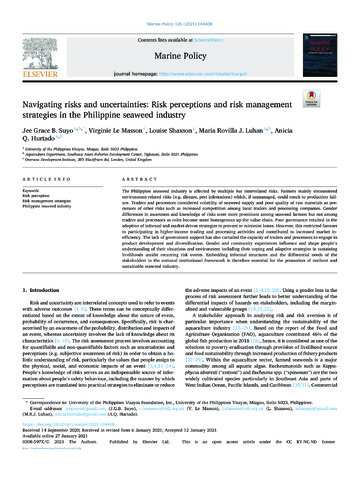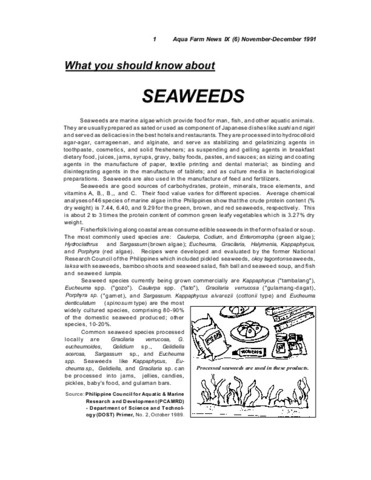Perlihatkan publikasi sederhana
Analysis of biosecurity-related policies governing the seaweed industry of the Philippines
| dc.contributor.author | Mateo, Jonalyn P. | |
| dc.contributor.author | Campbell, Iona | |
| dc.contributor.author | Cottier-Cook, Elizabeth J. | |
| dc.contributor.author | Luhan, Maria Rovilla J. | |
| dc.contributor.author | Ferriols, Victor Marco Emmanuel N. | |
| dc.contributor.author | Hurtado, Anicia Q. | |
| dc.date.accessioned | 2020-03-18T01:57:44Z | |
| dc.date.available | 2020-03-18T01:57:44Z | |
| dc.date.issued | 2020-03-10 | |
| dc.identifier.citation | Mateo, J. P., Campbell, I., Cottier-Cook, E. J., Luhan, M. R. J., Ferriols, V. M. E. N., & Hurtado, A. Q. (2020). Analysis of biosecurity-related policies governing the seaweed industry of the Philippines. Journal of Applied Phycology, 32, 2009-2022. https://doi.org/10.1007/s10811-020-02083-7 | en |
| dc.identifier.issn | 1573-5176 | |
| dc.identifier.uri | http://hdl.handle.net/10862/3586 | |
| dc.description.abstract | The seaweed industry in the Philippines is a significant contributor to aquaculture production, both nationally and internationally. It out-produces the capture fisheries sector and most global producers, with the exception of China and Indonesia. Seaweed species, particularly Kappaphycus and Eucheuma spp., have been farmed throughout the country since the early 1970s. In 2017, the Philippines produced 1.4 million tonnes (fwt) and exported 35,490 tonnes of seaweed and carrageenan with a value of US$174 million. However, a decreasing trend in seaweed production has been observed since the mid-2000s as a result of pest and disease outbreaks, among other factors, which have been exacerbated by climate change. This paper is the first to analyze biosecurity-related national policies and legislation (a.k.a. ‘frameworks’ collectively), which are relevant to the seaweed industry in the Philippines. A total of 12 frameworks were identified, of which a sub-set of seven were compared using defined biosecurity themes, risks, and management measures to evaluate how seaweed biosecurity is incorporated into national policy. The inclusion of biosecurity-related activities in national frameworks was found to be limited to aquatic animal commodities or agricultural crops. Only the Code of Good Aquaculture Practices (GAqP) for seaweed specifically included seaweed cultivation, however, it did not include any biosecurity measures. The results indicated a clear gap in current biosecurity legislation and policy in the Philippines, which if addressed have the potential to reduce the impact of endemic and emergent diseases and pests and support the sustainable growth of this important industry. | |
| dc.language.iso | en | en |
| dc.publisher | Springer Verlag | |
| dc.subject | Eucheuma | en |
| dc.title | Analysis of biosecurity-related policies governing the seaweed industry of the Philippines | en |
| dc.type | Article | en |
| dc.identifier.doi | 10.1007/s10811-020-02083-7 | |
| dc.citation.volume | 32 | en |
| dc.citation.spage | 2009 | en |
| dc.citation.epage | 2022 | en |
| dc.citation.journalTitle | Journal of Applied Phycology | en |
| dc.subject.asfa | biosecurity | en |
| dc.subject.asfa | policies | en |
| dc.subject.asfa | seaweed industry | en |
| dc.subject.asfa | seaweeds | en |
| dc.subject.scientificName | Kappaphycus |
Files in this item
| Files | Size | Format | View |
|---|---|---|---|
|
There are no files associated with this item. |
|||
Publikasi ini ada di koleksi berikut
-
Journal Articles [1258]
These papers were contributed by Department staff to various national and international journals.



